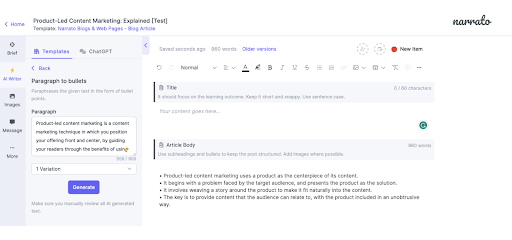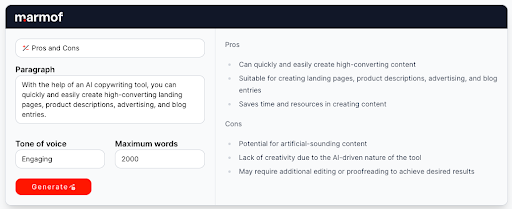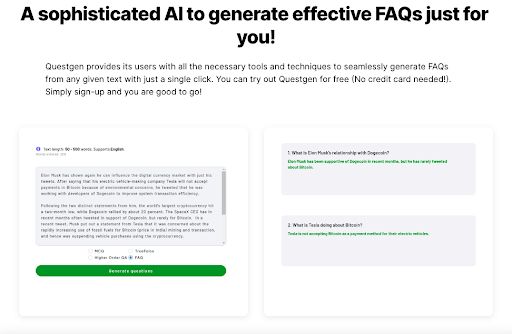Sam Makad
Sam Makad is a business consultant. He helps small & medium enterprises to grow their businesses and overall ROI. You can follow Sam on Twitter, Facebook, and Linkedin.
This post reveals 6 remarkable use cases of AI writers that will change your perception of generative AI and its applications. Discover the unique capabilities of tools like Narrato, Marmof, Questgen, and Smartcat.
88% of marketing professionals in an Adobe survey stated that the demand for content has grown by almost 2x since 2020.
And with the rapid growth of social media, online platforms, and other information-driven industries, this demand is showing no signs of slowing down either. The same survey has also found that content demand is expected to grow 5-20x (!) by 2024.
The question that needs answering here is - how are content creators and marketers supposed to meet this ever-increasing content demand?
Producing more content means having to work with tighter deadlines. And you wouldn't want your content quality to suffer either. What you need is an assistant who is always by your side to help you scale up your content creation efforts. And that's what AI writers are there for. These nifty AI tools can help you generate high-quality content with minimal effort.
If you're wondering how to extract maximum use out of AI writers, you've come to the right place. In the upcoming sections, we'll explore some interesting use cases of AI writers that you probably hadn't considered before.
Before we get to that, a little bit on the basics of AI writers.
Since the launch of ChatGPT in November last year, the buzz around generative artificial intelligence (AI), AI writers, and content creation tools has grown significantly. AI tools for content creation have sparked the curiosity of individuals, businesses, and industries alike. Powered by sophisticated algorithms and natural language processing (NLP) capabilities, these AI writers can augment human writers and automate repetitive tasks in a content creation workflow.
To put it simply, AI writers generate text with human-like accuracy by processing the input provided by a user. These AI writing tools are vastly from traditional content writing tools of the past. The unique thing about the AI content writer is that it is capable of adapting and improving its writing abilities without being constrained by a predetermined set of rules. All this tool needs is a bit of direction, like target keywords, product info, target audience, etc. And that is the magic of an AI writing assistant.
While AI writers can certainly help you craft your blog posts, social media posts, emails, and more, hitting the 'publish' button without giving the AI-generated content a good once-over could be a mistake. In fact, this kind of AI-generated content can be marked as spam by Google if it does not meet their E-A-T (expertise-authority-trustworthiness) guidelines. This is why human oversight is always necessary for AI content creation.
All AI writing tools are trained on a large corpus of existing data. GPT-3, for instance, was trained on almost 700 GB of data and has over 175 billion trainable parameters. And when we say "training", we are referring to the process of improving the AI tool's algorithm.
Every word in the training dataset is tagged, which helps the AI algorithm understand how human writers stitch words together to create a cohesive sentence. It learns the statistical patterns and structure of language. Humans then score the AI-generated output to improve accuracy. And over time, the AI tool gets better at predicting text.
Different AI writing systems may adopt different approaches. But the ultimate goal remains the same - to create language models that can comprehend and generate text resembling human writing with near-perfect accuracy.
Now, that we've covered the basics, let's explore how you can put these AI content writers to use.
From generating compelling articles and personalized marketing campaigns to helping marketers with language translation, new use cases of AI writers are coming up every day. Let's explore some fresh and interesting ways you can use AI writers to level up your content marketing game.
Repurposing your blog articles into social posts is a great way to get your content out there. But these kinds of social media posts are notoriously difficult to create.
Every social media platform comes with its own specifications for content length. For instance, Twitter only allows you to post content with 280 characters, while the character limit for LinkedIn is around 3,000 characters (or 500-600 words). That means that you would have limited space to convey the essence of your blog post.
To create these social posts, you would have to learn the art of converting long-form articles into more digestible short-form content. Or you can simply use the assistance of an AI writer.
Narrato is one such powerful AI writing software that comes with 40+ use cases for generating all kinds of textual content for blogs, emails, copy, and even videos. And you also get to customize the tone of the content, specify your target audience, and select the number of variations of AI-generated you want.
Besides the usual use cases like blog post intro/conclusion, product description, ad copy, and others, Narrato also offers some unique ones that could help you repurpose your blogs into social posts -

When you're creating a listicle-type blog post for a product, service, or anything else, you want to give your readers all the information they need to make the right choice. A pros and cons list can be a useful decision-making tool here.
Creating a pros and cons list might seem pretty simple and straightforward at first, but it's actually not that easy. Personal biases can come into play, and assigning appropriate weight and priority to each point can get difficult. It's also quite time-consuming to list the pros and cons for each item in the list.
Marmof is an AI tool for writing that comes with a dedicated use case for building a pros and cons list. All you have to do is provide it with some context and select your tone and word limit. The tool will create a fantastic pros and cons list in a matter of seconds.

To stand out from the crowd in the world of content, you have to look for ways to make your content more engaging for readers. And there's no better way to do that than by storytelling marketing. This is a marketing technique in which you build a narrative (or story) to communicate your marketing message. It's a great way to grab the attention of your readers and increase their dwell time on your page.
Storytelling, of course, requires human creativity, but that does not mean an AI tool can't help you here. It can spark ideas to help you build a compelling narrative. It can also give you a new perspective on approaching a topic.
Narrative Device is a unique AI article writer that is designed specifically for storytelling. When you provide the tool with two themes, it builds a narrative around that. And then it's just the matter of polishing the story, and adding your own creative elements to it.
You can also take the help of ChatGPT to build an introductory narrative for your article. Input a ChatGPT prompt that goes something like this:
"Write an engaging introduction for the topic 'Topic'. Build a story and include an anecdote to make it interesting." Here's an example from Narrato's ChatGPT integration.
FAQs can be great for addressing common questions and concerns, providing valuable information to your audience, and enhancing the user experience. It's an excellent way to build audience trust. But, did you know that it could help with SEO too?
If you target the right user queries and keywords, it can increase the visibility of your FAQ page in search engine results. Adding an FAQ section at the bottom of your blog post or article can also help you get a featured snippet, which is helpful for driving organic traffic to your site.
But creating FAQs can be quite tedious and time-consuming. AI writers, on the other hand, are great at handling these kinds of repetitive tasks. Do a quick Google search and you'll find tons of AI writers with FAQ-generation capabilities.
Questgen is one such tool that comes with a dedicated AI-powered FAQ generator. Just write/paste some text to provide some context, and the AI tool will generate a list of relevant FAQs.

Narrato's AI writer also has a QnA use case, using which you can generate concise and targeted answers to commonly asked questions. ChatGPT does a pretty good job of generating FAQs as well.
Localized marketing can be an excellent strategy for targeting audiences in foreign markets. And if you know how to tailor your marketing messages according to the tastes and preferences of the local audience, you can certainly boost audience engagement.
Language is also an important part of the equation here. It helps establish a stronger connection with your potential customers. It also signals that your business understands and values the local community. To convey your marketing message in regional languages, you need an AI article writer with translation capabilities. Something like Smartcat.
Smartcat is an AI-powered translation tool that uses machine learning to give you precise translations in over 280 languages. The unique thing about this tool is that it is capable of providing contextual translations. This means that the essence of your marketing message would not get lost in translation.
Research has found that you have 8 seconds or less to grab your viewers' attention with your video content. If you don't have a compelling hook intro for your video, your audience might skip your content and move on to the next.
Whether you're creating videos for your YouTube channel or a video ad as part of your marketing strategy, you'll want your viewers to stay long enough to hear your message. An AI writer with a 'Video Hook Intro' use case can be quite useful here. It can give you ideas on how to craft an attention-grabbing hook and make a smooth transition into the intro.
AI writers can help you in more ways than one. But here's the thing: If you want to extract maximum use out of an AI content writer, it's important to use them correctly.
Even the best AI content writer would not be able to get you the results, if you end up making common AI content creation mistakes -
It's evidently clear that the use cases of AI writers extend far beyond what meets the eye. While blog content, product descriptions, Facebook ads, web copy, etc. are some of the more commonly recognized applications, AI writers offer numerous unique and lesser-known use cases.
In this article, we covered 6 unique AI writer use cases with tools that will hopefully help you in your content marketing efforts. And we're sure there will be many more. Let us know about some unique applications of AI writers that you found.
You’ll also receive some of our best posts today

Sam Makad is a business consultant. He helps small & medium enterprises to grow their businesses and overall ROI. You can follow Sam on Twitter, Facebook, and Linkedin.
Marketing gurus are all saying that in order to...
When you have a big-ticket service or a digital...

User reviews are a game-changer for e-commerce. Consumers rely heavily o...
Don’t miss the new articles!